Enhancing Ansible’s skills is the greatest method to have a solid job in the automation sector. Ansible is a DevOps technology that allows you to improve your abilities while also landing high-paying employment. Those who are new to this industry may wonder what Ansible is and why it is so popular. So, in this blog, we’ll go through every aspect to ensure that you get the most out of Ansible. Let’s first get some understanding of Ansible.
Overview of Ansible
Ansible is a free tool for automation. It helps you control many servers and network devices using one place. It relies on an easy-to-understand language called “playbooks,” which outlines the steps for setting up and managing things the way you want.
Ansible works without agents, so you don’t need extra software on the systems you’re managing. It uses SSH to connect and control them from a distance. This tool simplifies IT tasks by centralizing management and automation, making it convenient for organizations to handle their systems and apps.
It supports multiple operating systems, including Linux, Unix, and Windows, and it can be used to manage a wide range of IT operations, from simple tasks like updating configuration files to complex multi-tier deployments.
One of the key benefits of Ansible is that it requires no special coding skills or extensive programming knowledge, as the YAML language used to describe systems is easy to learn and understand. Additionally, Ansible supports a modular architecture, making it easy to reuse existing automation scripts and add new ones as needed.
Advantages of Ansible:
Ansible offers several advantages, including:
- Simple and easy to use: Ansible uses an easy-to-understand language called YAML to define how systems should be, so even people without technical skills can automate IT jobs.
- Agentless architecture: Ansible uses SSH to communicate with and manage remote servers, so there is no need to install agents on target systems, reducing complexity and increasing security.
- Modular design: Ansible uses a modular design, making it easy to reuse existing automation scripts and add new ones as needed. This allows organizations to create and manage complex automation solutions using a building block approach.
- Cross-platform compatibility: Ansible supports multiple operating systems, including Linux, Unix, and Windows, making it a versatile solution that can be used to manage IT operations across a heterogeneous environment.
- Large community: Ansible boasts a big, lively community of users and developers who contribute to its growth and offer assistance to others. This support network makes it simpler for organizations to find help and resources whenever required.
- Scalable and extensible: Ansible can be used to manage a wide range of IT operations, from simple tasks like updating configuration files to complex multi-tier deployments. Additionally, it is easily extensible, allowing organizations to add custom functionality as needed.
- Cost-effective: Ansible is open source software, so it is available at no cost. Additionally, its simple design and ease of use make it a cost-effective solution for automating IT operations, as organizations can get started quickly and with a lower investment of time and resources.
Why maximize Ansible Skills?
Maximizing your Ansible skills can bring several benefits:
- Increased productivity: With strong Ansible skills, you can automate repetitive tasks and manage multiple servers or devices at once, saving you time and effort.
- Consistency: Ansible allows you to apply the same configurations and settings across multiple servers, ensuring consistency and reducing the risk of errors.
- Scalability: As your infrastructure grows, Ansible can help you manage it more efficiently and effectively, without the need for additional manual effort.
- Standardization: Ansible can help you establish and enforce best practices and standard configurations across your organization, promoting consistency and security.
- Career advancement: Ansible is a popular and in-demand tool in the DevOps world, and mastering it can help you stand out and advance in your career.
Top Features of Ansible Skills
Ansible has several features that make it a powerful tool for automating IT operations, including:
- Configuration management: Ansible is capable of managing configuration files, installing packages, and handling system settings. This helps organizations maintain uniform and standardized configurations across their entire infrastructure more easily.
- Application deployment: Ansible can be used to deploy applications and their dependencies, making it easier for organizations to manage and maintain their applications, even as they evolve over time.
- Infrastructure provisioning: Ansible can automate the process of setting up and managing infrastructure, which includes creating cloud resources and setting up virtual machines automatically.
- Continuous delivery: Ansible can be integrated with a continuous delivery pipeline, allowing organizations to automate the deployment of new releases, ensuring that changes are deployed consistently and quickly.
- Multi-tier deployments: Ansible can be used to manage complex, multi-tier deployments, making it easier for organizations to manage their applications, even as they grow and evolve over time.
- Idempotent execution:
- Ansible scripts are designed to be idempotent, ensuring that they can be executed multiple times without causing unintended changes. This feature allows organizations to safely test and retest their automation scripts without worrying about unexpected outcomes.
- Role-based access control: Ansible supports role-based access control, allowing organizations to manage access to automation scripts and control who can run them.
- Plug-in architecture: Ansible has a plug-in architecture, allowing organizations to extend its functionality as needed. This makes it possible to integrate with other tools and systems, making it easier for organizations to automate their IT operations end-to-end.
Ansible skills and Architecture
Below you can see the basic architecture of Ansible that includes modules, plugins, inventories, playbooks, and APIs.

Coming onto the most important part of this article which is to improve Ansible skills.
Ansible Skills Enhancement Using Various Tasks:
Now, we are familiar with the Ansible features, and learning Ansible skills is a reasonable option for aspiring IT professionals. Moreover, understanding and enhancing skills in Ansible can be the perfect way for a candidate to improve skills. The only way to develop expert-level Ansible abilities, however, is via actual usage and doing some of the tasks that you would encounter in the real world. Thus, let’s begin with user tasks to enhance skills.
1. Process of Patching systems and installing applications
Ansible serves as a straightforward tool for managing configurations, simplifying challenging tasks. Particularly for Sysadmins, one of the toughest aspects involves patching systems. Whenever you receive security notifications like CVE or IAVA, you’re required to take steps to address security vulnerabilities.
In this, Ansible helps in reducing the time to patch systems by running packaging modules. In this, we will use the Yum Module to update the system. However, Ansible can also install, update, remove, or install from another location. Here is the task for updating the system:

Coming on to the next one that is to simplify the task.
2. Simplifying tasks process in Ansible
As we know Ansible can help in making patching systems easier. Therefore, you can run some ad-hoc commands involving different methods for simplifying tasks. In this segment, you will get an understanding of the use of Ansible for automating repetitive tasks for users.
The different tasks included in Ansible are managing users, package installation, starting services and provisioning a system.
Firstly, let’s start with the management of users.
3. Managing users
This is a basic skill of Ansible in which if you need to create a large list of users and groups among the different groups then you can use loops. Let’s start by creating the groups,
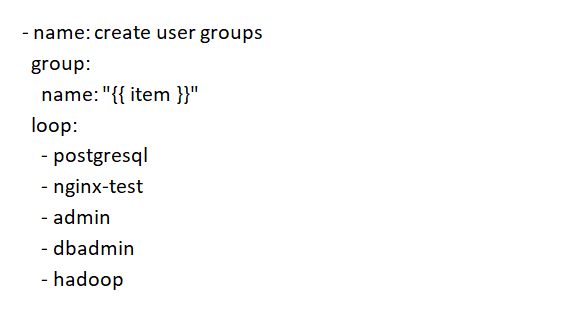
Then, in this, you can also maximize the ansible skills by creating users with specific parameters like in the following example.
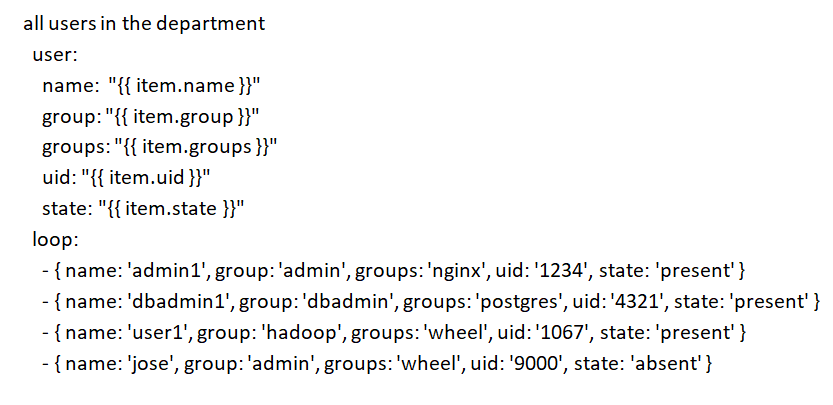
4. Installation of packages
The way you install packages can vary based on the packaging system you’re working with. Ansible’s facts help decide which module to employ for this purpose. Additionally, Ansible provides a versatile module named “package” that relies on ansible_pkg_mgr and triggers the appropriate package manager according to the system.
The package module is suitable for straightforward package installations. However, for more intricate tasks, you should select the proper module for your system. For example, if you’re dealing with an RHEL-based system and need to disregard GPG keys while installing security packages, opt for the yum module.
Here is an example using the package module:

The below-given example is showing how a yum module installs NGINX. And, skips the broken packages, disables ‘gpg_check’ from the repo with ignoring the repository certificates.
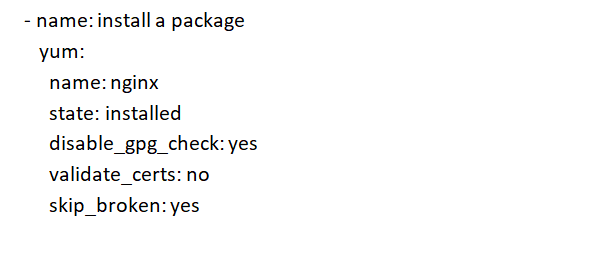
5. Starting services
Same like packages, Ansible has various modules to start services. Like in previous where the package module does a general installation of packages. Similarly, the service module does similar work with services, including system and Upstart.
Here is an example:
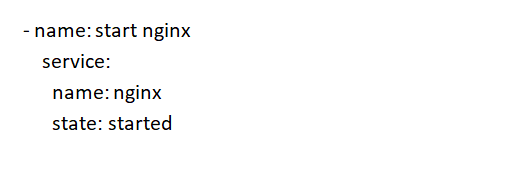
Moreover, you can use Ansible’s service module if you are starting and stopping applications. But, like the yum module, if you want more options then, you have to use the system module.
6. Provisioning System
Provisioning a system is for provisioning a virtual machine (VM) with the OpenStack cloud solution.
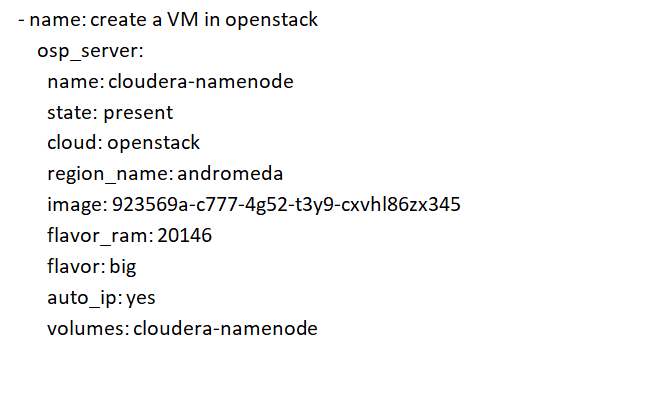
However, in the above code the configuration uses the osp-server module that is for adding or removing an instance. Furthermore, it contains the virtual machine’s name and the method it uses to verify its identity with the API. Here’s an example below that demonstrates initiating the server and informing the modules about the instance’s name:
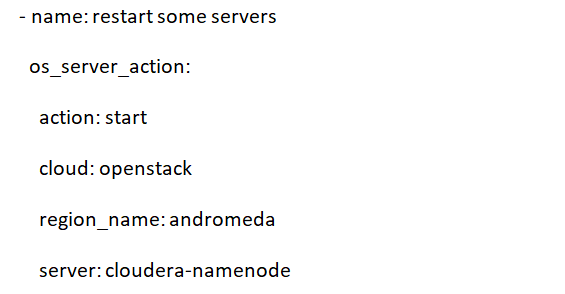
7. Doing other things
This includes the Use the shell and command modules that allows for running any command line. Example using the OpenStack CLI:

Using Ansible Operators in Kubernetes
Ansible fits into a Kubernetes workflow using YAML to explain the desired state of the world. Moreover, multiple projects, including the Automation Broker are using Ansible for use behind specific APIs.
However, an Operator refers to a Kubernetes controller for deploying and manages a service or application in a cluster. This automates human operation knowledge and provides best practices to keep services running and healthy. Further, it also includes the Memcached Operator, which can deploy as a service running in a cluster, and it also includes a custom resource definition for a resource called Memcached. Below an example is provided for requesting a Deployment with three Pods.
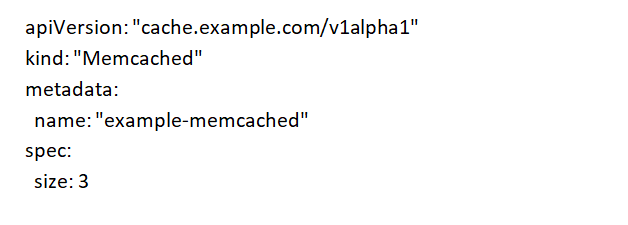
Now, that we are familiar with the services that can maximize Ansible skills. In the next section, we will have a short talk about Ansible terminologies.
Basic Ansible Terms:
Here are some basic terms in Ansible:
- Playbook: A playbook is like a set of instructions written in a YAML file. It explains how a system should look and what actions need to be taken to make it look that way. Each playbook has different sections, called plays, which detail the specific actions needed to configure different parts of the system.
- Play: A play is a series of tasks that define the desired state of a single component of a system. A play defines the tasks that are to be executed on a particular set of hosts and the order in which they are executed.
- Task: A task is a single operation that Ansible performs on a host. Tasks can include operations such as installing packages, copying files, and running commands.
- Module: A module is a pre-written piece of code that performs a specific task, such as installing a package or copying a file. Ansible has a large library of built-in modules that cover a wide range of IT operations.
- Inventory: The inventory is a list of the hosts that Ansible will manage. The inventory can be defined in a variety of formats, including a simple text file or a dynamic inventory script that generates the list of hosts in real-time.
- Variable: A variable is like a labeled value that playbooks and templates can use. Variables help you make playbooks more flexible and reusable by letting you customize them easily.
- Template: A template is a special file that outlines how a configuration or text-based document should look. In Ansible, templates are crafted in a language called Jinja2, and they can also include variables. This makes it simple to create custom configuration files tailored to different environments.
Popular DevOps Certification Exam
The top DevOps certifications that you can apply for with having the good knowledge and skills in Ansible Includes,
Microsoft Azure DevOps Solutions (AZ-400) Exam
Microsoft Azure DevOps Solutions AZ-400 exam is for those individuals who are DevOps professionals and have already received the badge of Azure Developer Associate. Moreover, this exam measures your ability to design a DevOps strategy and implement DevOps development processes. However, the responsibilities of DevOps professionals are to streamline the delivery by optimizing practices, improving communications and creating automation.
AWS Certified DevOps Engineer Professional (DOP-C01)
AWS Certified DevOps Engineer Professional test evaluates your understanding of handling, setting up, and supervising distributed systems and apps using AWS. It also checks if you can put into action and oversee continuous delivery systems and methods on AWS.
Google Professional Cloud DevOps Engineer (GCP) Exam
This GCP exam has been designed to test the technical skills related to the job role. Moreover, the candidates preparing for the exam should have hands-on experience ability to,
- Firstly, applying site reliability engineering principles to a service.
- Secondly, optimizing service performance.
- Thirdly, implementing service monitoring strategies.
- Lastly, building and implementing CI/CD pipelines for a service.
LPI DevOps Tools Engineer (701-100) Exam
The LPI DevOps Tools Engineer certification confirms your ability to work with tools that improve cooperation in workflows for system administration and software development. The exam concentrates on practical skills essential for excelling in a DevOps setup using popular DevOps tools.
Ansible: Top Companies
This needs to be mentioned, as there are top organizations that are looking for individuals having knowledge in DevOps. Some of them include,
- IBM
- Ciena
- Amdocs
- Amazon
- Accenture
Conclusion
Ansible as a DevOps tool is gaining a lot of popularity and many individuals are showing interest in enhancing ansible skills. Moreover, in this article, you have understood the tasks that help you learn and understand ansible easily. Apart from this information, you can also go for online training courses. The reason behind this is that there you will get good study material with practice and tutorials related to DevOps. So, start your Ansible learning journey right now!
Learn and enhance your Ansible skills. Become a Certified DevOps Professional Now!

